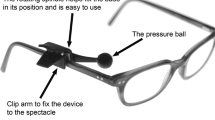Abstract
In this case report, a 50-year-old female with a chronic blepharospasm (spasmodic winking) around both eyes was treated with 17 sessions of electromyographic (EMG) feedback. EMG level and spasm frequency were monitored during baseline, placebo, and feedback treatment sessions. There was a marked decrease in both EMG level and spasm frequency, which generalized to her everyday life. Improvement was maintained at a 4-month follow-up.
Similar content being viewed by others
References
Barlow, D. H., & Hersen, M. Single case experimental designs.Archives of General Psychiatry 1973,29 319–327.
Reckless, J. B. Hysterical blepharospasm treated by psychotherapy and conditioning procedures in a group setting.Psychosomatics 1972,13 263–264.
Sharpe, R. Behaviour therapy in a case of blepharospasm.British Journal of Psychiatry 1974,124 603–604.
Author information
Authors and Affiliations
Rights and permissions
About this article
Cite this article
Peck, D.F. The use of EMG feedback in the treatment of a severe case of blepharospasm. Biofeedback and Self-Regulation 2, 273–277 (1977). https://doi.org/10.1007/BF00998652
Received:
Issue Date:
DOI: https://doi.org/10.1007/BF00998652




